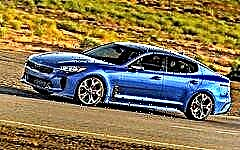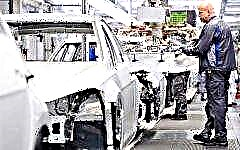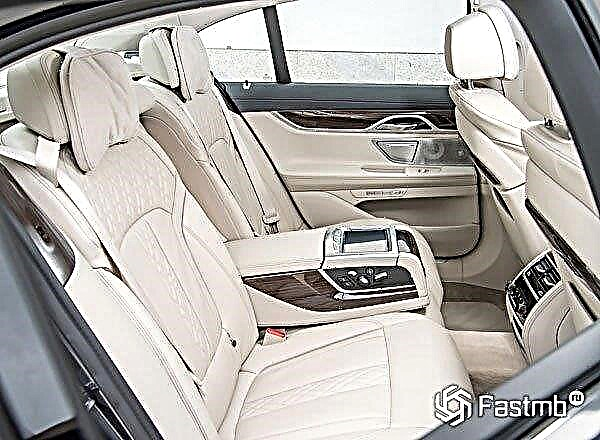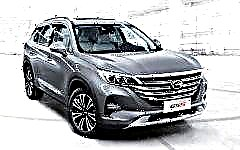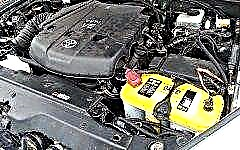

The content of the article:
- Battery for off-road vehicles with petrol engines
- Battery for off-road vehicles with electric motors
“Electric cars, electric cars, literally flooded everything ...” - so, paraphrasing a fragment of the famous retro-slider, one can describe the perspective of the world auto industry.
Although the share of light electric vehicles on European roads is not so high (what can we say about the post-Soviet space), many automakers, sometimes motivated by various subsidies and tax incentives, consider it a matter of honor to launch their version of the electric car on the assembly line.
However, there are also skeptics, such as Jaguar Land Rover, which is in no hurry to convert heavy SUVs to clean electricity due to the heavy weight of the batteries intended for this. What batteries are better suited for SUVs? Let's figure it out.
Battery for off-road vehicles with petrol engines
1. Optima RedTop

This section of the rating is opened by the Optima RedTop AGM battery. The battery weighing just over 17 kg has a starting current of 815 A with a capacity of 50 A-hour.
Such a serious capacity of the energy storage is due to the peculiarities of its design. So, in the battery banks there are lead plates, which are larger than in similar batteries.
The battery tolerates frost well and continues to supply current even at very low temperatures. Therefore, the scope of such batteries is quite wide: these are all-wheel drive cars, trucks, SUVs.
The completely sealed battery housing prevents electrolyte from leaking out or being blown away. In addition, the battery can be used in different positions, so that even when turned to the side, the electrolyte inside will not run away anywhere.
Advantages:
- high starting current;
- long service life;
- full energy output;
- stable performance;
- works at temperatures from +40 to -40 C;
- resistant to external factors.
Flaws:
- high price.
2. Varta AGM

The series is continued by the Varta battery weighing about 17 kg, giving out electricity with a force of 680 A. The shape and structure of the battery allows it to be used, like Optima, in any position.
Thanks to the electrolyte in the glass fibers of the separator, Varta has significant mechanical stability. For lovers of off-road pokatushek - a great option.
In this case, the active mass of the plates of the accumulator is maintained throughout its entire service life, without melting. The endurance of the Varta AGM battery has been proven in a series of tests, but it needs to be recharged in time for optimal performance.
Advantages:
- high quality;
- compactness;
- equipped with a convenient handle for transportation;
- the housing is reliably protected from leaks.
Flaws:
- needs constant care.
3. Bosch Silver

A model from a well-known manufacturer of household appliances, delivering a current of 420 A. One of the advantages of this battery is high energy output with a fairly low weight - only 15 kg.
The silver used in the manufacture of these batteries ensures a long service life. And the manufacturer guarantees that the plates will not deteriorate from a large number of charges.
Just in case, Bosch Silver is backed by a safety margin. In addition, the battery has an optimal level of safety during its use.
Advantages:
- unpretentious in maintenance;
- has a high starting power;
- sealed housing eliminates the possibility of electrolyte leakage;
- minimum self-discharge.
Flaws:
- high price;
- electrolyte can freeze at low temperatures.
4. Delta GX 12-60

A 24 kg battery with lead acid filling. The model is developed using GEL technology, with a pasty electrolyte inside, the function of which is performed by sulfuric acid. A distinctive feature of the Delta is its high resistance to deep discharges.
The unit body is made of non-combustible shock-resistant ABS plastic. The battery can be used in a continuous charge-discharge mode. On average, the battery has a lifespan of up to 10 years.
Advantages:
- minimum internal resistance;
- insignificant self-discharge;
- long service life;
- does not emit harmful vapors;
- there is no need to control the water level.
Flaws:
- relatively high cost.
5. Moll AGM Start-Stop 60R 640A

Closes the section for cars with gasoline engines and the Moll AGM Start-Stop 60R 640A model. The robust design, along with the use of modern technologies that prevent electrolyte leakage, create the conditions for a long service life of the unit. In this regard, Moll is one of the market leaders; on average, the battery lasts for 7-8 years.
The compact size and low weight of the battery greatly facilitate its installation and removal. The starting current with a force of 640 A is stably maintained even in severe frosts, up to -30 degrees.
The design of the battery uses a special arrangement of plates aimed at protecting against vibration loads and increasing the starting current power. The battery has no significant drawbacks.
Features of the model:
- capacity: 60 Ah;
- voltage: 12V;
- weight: 18.4 kg.
Battery for off-road vehicles with electric motors
1. Hyundai Kona Electric "Long-range"

This model of a rather compact SUV received an increased battery capacity of up to 64 kWh and a range of up to 449 km. At the same time, the electric motor also became much more powerful - with an indicator of 150 kW instead of the former 99 in the previous modification of the car.
As a result, the mobile properties of the Kona have also changed. In particular, the SUV takes 7.6 seconds to accelerate from 0 to 100 km / h instead of 9.3 seconds, as was the case with a model with a less capacious battery.
The maximum speed of 167 km / h remained the same, as did the torque of 395 Nm, only the power consumption per 100 km increased from 14.8 to 15.2 kWh, which, in principle, is not so scary against the background significantly improved other parameters.
Features of the battery:
- type of battery - lithium-ion polymer;
- charging through a 7.2 kW device - 9 hours 40 minutes;
- charging through a 100 kW device up to 80% - 54 minutes.
2. Kia Niro EV

Experts call this car a station wagon masquerading as a subcompact crossover, but with an electric drive. The car is equipped with an electric motor that produces 150 kW (204 hp) of power and 395 Nm of torque, allowing the SUV to accelerate from 0 to 100 km / h in just 7.8 seconds.
The battery with a capacity of 64 kWh makes it possible to travel 385 km without recharging, which is quite enough for car walks within the city limits.
A crossover model is also offered with a 39.2 kWh battery, in this case, the travel range without charging will be up to 246 km. The battery module is located directly under the passenger compartment, which creates a low center of gravity, provides a stable position of the car and comfortable control of it on winding routes.
Features of the battery:
- type of battery - lithium polymer;
- charging with a 7.2 kW device - 9 hours 35 minutes;
- charging with a 100 kW device up to 80% - 54 minutes;
- charging up to 80% at a station with a capacity of 50 kW - 1 hour 15 minutes.
3. Audi e-tron 55 quattro

The first electric vehicle in the brand's lineup. The all-wheel drive crossover is provided by two asynchronous motors located on the front and rear axles, producing a maximum power of 135 and 165 kW, respectively, and jointly producing up to 300 kW at a speed of 664 N? M.
The SUV accelerates from 0 to 100 km / h in 5.7 seconds, but its top speed is electronically limited to 200 km / h. If the ride is not too fast, the car uses only the rear motor, and only when switching to active drive is the front one connected.
As for the innovative power supply system of the crossover, it is located under its body, close to the center of the car.In a battery 2.28 m long, 1.63 m wide and 34 centimeters high, 36 modules with cells are assembled on two levels. Each of these blocks is equipped with a flexible polymer shell with an aluminum coating.
The 396 V battery has a capacity of 95 kWh, which is enough for 400 kilometers. The gel located under the battery cells evenly transfers thermal energy to the cooling system through the battery case. Moreover, this system is able not only to remove heat from the battery, but also to direct up to 3 kW of energy to heat the passenger compartment.
Battery Features:
- weight - 699 kg;
- charging from an 11 kW device - 8.5 hours;
- charging from an optional 22 kW device - 4.5 hours;
- charging at 150 kW to 80% capacity - 30 minutes.
4. BMW iX3

The crossover, slated to begin production in 2020, is set to be the first embodiment of the brand's new strategy to launch BMW models with multiple transmission options, including an electric one. The iX3 has a completely redesigned drive system and battery.
The electric motor featured in the SUV produces 210 kW (286 hp) with 400 Nm of torque transmitted to the rear wheels. And the range of travel without recharging over 440 km is provided by the high-voltage battery, which has already become an integral part of the 5th generation BMW eDrive models.
Before getting into the car, the battery components are grouped into modules at BMW's production units. And already these modules form high-voltage batteries corresponding to the required model.
In its segment, the iX3 crossover is distinguished not only by its fairly low power consumption - less than 20 kWh per 100 km according to test results, but also by an excellent ratio of battery size to range.
In general, this battery shows the optimal performance from what can be obtained today. It is also worth noting that BMW engineers managed to reduce the cobalt content in the battery by two-thirds.
Battery Features:
- type - lithium-ion;
- capacity - 74 kWh;
- charging at a station of 150 kW - 30 minutes.
5. Rivian R1S

The review is completed by the R1S SUV, which, along with the R1T pickup truck, Rivian intends to equip with the batteries with the highest capacity values among the existing batteries for passenger cars.
It is assumed that these batteries will be able to store 180 kWh of electricity, providing a range that is quite impressive for an ordinary car, and even more so for such large and heavy ones.
The manufacturer intends to present new batteries in the fall of 2020, but for now the company's specialists are trying to improve some elements of the power supply design - in particular, liquid cooling.
At the same time, Rivian is also developing smaller capacity batteries - for 105 and 135 kWh. But still, they are ahead of the coolest Tesla battery in this indicator! And if the Rivian SUV gets a 105 kWh battery, then on a single charge the electric car will be able to travel about 385 km. At the same time, on a 135 kWh battery, it will have a cruising range of about 500 km.
Battery Features:
- guaranteed cruising range - 660 km;
- contains at least 7776 elements.
Conclusion
Until recently, the segment of electric vehicles was mainly represented by hatchbacks with VIP-class models and the only ultra-expensive off-road vehicle Tesla Model X. However, everything flows, everything changes, and traditional gasoline crossovers are already signaling electric ones from behind.
And despite the serious differences in the design and capacity of the batteries for these two groups, the basic requirements for batteries for off-road vehicles are largely the same. This is resistance to adverse climatic conditions, vibration, mechanical stress. And the cost has not gone anywhere.





